

Devanagari. Origins[edit] Devanagari is part of the Brahmic family of scripts of Nepal, India, Tibet, and South-East Asia.[4] It is a descendant of the Gupta script, along with Siddham and Sharada.[4] Eastern variants of Gupta called nāgarī are first attested from the 7th century CE; from c. 1200 CE these gradually replaced Siddham, which survived as a vehicle for Tantric Buddhism in East Asia, and Sharada, which remained in parallel use in Kashmir.
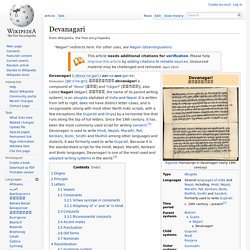
An early version of Devanagari is visible in the Kutila inscription of Bareilly dated to Vikram Samvat 1049 (i.e. 992 CE), which demonstrates the emergence of the horizontal bar to group letters belonging to a word.[1] nāgarī is the Sanskrit feminine of nāgara "relating or belonging to a town or city".
It is feminine from its original phrasing with lipi ("script") as nāgarī lipi "script relating to a city", that is, probably from its having originated in some city.[5] Devanagari text from Vayu Puran Principle[edit] Letters[edit] Vowels[edit] Consonants[edit] » other conlangs Dothraki. I got a question from Hrakkar which begins: This thread brings up a good question: What is ‘lexical form’ for Dothraki?
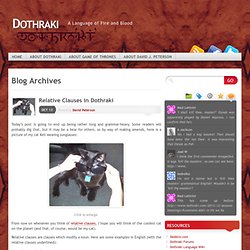
To read the full question, go here. Basically, I think there’s two questions here: What is the citation or dictionary form of a given Dothraki word? What is the bare stem in Dothraki? I’ll try to answer both questions. To begin to answer both of them, first I’ll go over how the language is built. Kamakawi is a language that is largely isolating with some agglutination. Click to enlarge. As you can see, in Kamakawi’s dictionary a single word is used as the head of each entry, and related words that differ in form get a new entry. Each root, then, gets its own entry, and words derived from that root (usually via noun class suffix) is listed under that entry. As I think I mentioned somewhere, Dothraki is built in the same way Zhyler is (I like to think of Dothraki as being run on a Zhyler engine).
Here’s one quick example using the root em: emat (v.A) to smileeme (ni.A) smile. Ktav Ivrit: The Ancient Hebrew Alphabet. Ktav Ivrit: The Ancient Hebrew Alphabet Also called Paleo-Hebrew, Phoenician and Canaanite, the common alphabet of the Levant and Sinai was the same as used by the Hebrews and Israelites, even by Moses to write the Torah, and by all indications the same as was used by Adam, Enoch and Noah.
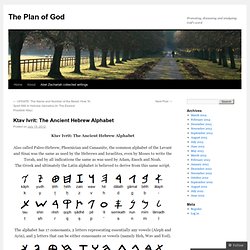
The Greek and ultimately the Latin alphabet is believed to derive from this same script. The alphabet has 17 consonants, 2 letters representing essentially any vowels (Aleph and Ayin), and 3 letters that can be either consonants or vowels (namely Heh, Wav and Yod). It is written from right to left, naturally lending itself to a graceful penmanship pattern of chopping down in lines or arcs to the left, the shape of the letters being based primarily on a vertical line with a swipe sideways. ~~ Abel Zechariah Like this: Outline of the Japanese Writing System. Jack Halpern Editor in Chief Kanji Dictionary Publishing Society (KDPS) Revised: July 20, 2001 Copyright ©1990-2001 by KDPS Based on the New Japanese-English Character Dictionary May not be reproduced without written permission 1.1 The Birth of a Pictographic Script Until recently, it was believed that the earliest examples of Chinese characters were those found in oracle bones used in divination rites dating back to the eighteenth century B.C.
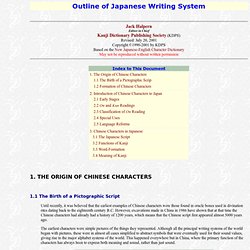
However, excavations made in China in 1986 have shown that at that time the Chinese characters had already had a history of 1200 years, which means that the Chinese script first appeared almost 5000 years ago. The earliest characters were simple pictures of the things they represented. Although all the principal writing systems of the world began with pictures, these were in almost all cases simplified to abstract symbols that were eventually used for their sound values, giving rise to the major alphabet systems of the world. 1. 2. 3. 4. Pinterest. Unicode Burmese Language Kit from XenoType Technologies. Brand new support for Unicode 5.1!
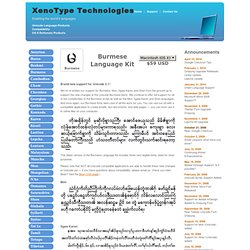
We’ve re-written our support for Burmese, Mon, Sgaw Karen and Shan from the ground up to support the new changes in the Unicode Burmese block. We continue to offer full support for all of the complexities of the Burmese script as well as the Mon, Sgaw Karen and Shan languages. And once again, our Burmese fonts take care of all the work for you. You can use our kit with a compatible application to create emails, text documents, and web pages — you can even use it to name files on your computer. This latest version of the Burmese Language Kit includes three very legible fonts, ideal for most purposes. Please note that NOT all Unicode compatible applications are able to handle these new changes to Unicode yet — if you have questions about compatibility, please email us. Mon Sgaw Karen Support for Pwo Karen will be added in the future. April 15, 2010 Google Checkout Tips February 1, 2010 Drepung Upgrade Released Limbu Update Lepcha Update January 31, 2010. Other African Scripts. Travel: The Korat script.
A hybrid writing system The short-lived civilization of the small Korat island in the Atlantic Ocean left us with a fascinating writing system, to my knowledge unlike any other system ever conceived.
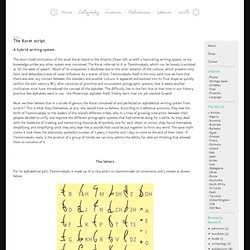
The Korat referred to it as Tsomínnakadu, which can be loosely translated as "all the seeds of speech". Much of its uniqueness is doubtless due to the utter isolation of the culture, which presents only faint (and debatable) traces of outer influence. As a matter of fact, Tsomínnakadu itself is the only solid clue we have that there was ever any contact between the islanders and another culture. It appeared and evolved into its final shape so quickly (within the 10th century BC), after centuries of primitive and inconsistent pictographic systems, that it seems another civilization must have introduced the concept of the alphabet.